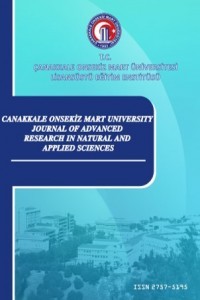Metalik-Benek Dokulu Sanatsal Seramik Sırların Geliştirilmesi: Yüzey Aşınma Özelliklerinin İncelenmesi
Aşınma, benek efekt, seramik karo, metal oksit, sinterleme
Development of Metallic-Speck Textured Artistic Ceramic Glazes: Investigation of Surface Abrasion Properties
Abrasion, speck effect, ceramic tile, metal oxide, ceramic glaze,
___
- Bakanlığı, M. E. (2007). Seramik ve Cam Teknolojisi. Ankara: Mesleki Eğitim ve Öğretim Sisteminin Güçlendirilmesi Projesi.
- Brummel, L. (2020). The Development of an Innovative Glazing Technique for the Raku Kiln. Avustralya: Central Queensland University.
- Casasola, R. J. (2011). Glass–ceramic glazes for ceramic tiles: a review. Journal of Materials Science, 553-582.
- Encarna Bou, A. M. (2006). Microstructural study of opaque glazes obtained from frits of the system: SiO2-Al2O3-B2O3-(P2O5)-CaO-K2O-TiO2. Journal of the European Ceramic Society, 1791-1796.
- Gizem Ustunel, C. Y. (2021). Prevention of mat glazed acid permeability used in monoporosa wall ceramics. Environmental Technology & Innovation, 101628.
- Gülşah Divitçioğlu, M. F. (2021). Usage olive seed ash in artistic ceramic glazes. Journal of Awarenes, 155-164.
- Güneş, P. Ç. (2015). Renk Veren Oksitlerle Geliştirilen ‘Stoneware’ Sır Araştırmaları. Yedi: Sanat, Tasarım ve Bilim Dergisi, 135-142.
- Hamdzun Haron, S. A. (2014). The Formulation of Ceramic Bodies using the Toba Volcanic Ash of Lenggong. Jurnal Teknologi, 99-104.
- Hongjun Huang, J. Y. (2020). Preparation of A High-Performance Frit Glaze Using High-Potassium Feldspar. IOP Conf. Series: Earth and Environmental Science. Japan: IOP Publishing.
- Huaron, S. (2013). Preparation of Lead Free Golden-like Metallic Luster Glaze. Materials Science.
- Kamuran Özlem Sarnıç, L. K. (2007). Eskişehir Bölgesi Şeker Pancarı Küspesi Küllerinin Sır Bileşeni ve Renklendirici Olarak Kullanılabilirliğinin Araştırılması. IV Uluslararası Katılımlı Seramik Cam Emaye Sır ve Boya Semineri , (s. 204-2014). Eskişehir.
- Karmakar, B. (2017). Functional glass-ceramics. B. Karmakar içinde, Functional Glasses and Glass-Ceramics Processing, Properties and Applications (s. 119-208). Birleşik Krallık: Butterworth-Heinemann.
- Kubat, L. (2020). Kestane Kabuğu Külünün Sır Bileşeni Olarak Kullanılabilirliğinin Araştırılması . Akademik Sanat, 61-70.
- Kurt Strecker, H. B. (2014). Formulation of Ceramic Glazes by Recycling Waste Glass. Materials Science Forum, 635-641.
- Leidy Johana Jaramillo Nievesa, A. V. (2020). Digital decoration for ceramic tiles: The effect of glazes particle size distribution on the inkjet decoration. Boletín de la Sociedad Española de Cerámica y Vidrio, 44-48.
- Olga Opuchovic, A. K. (2015). Historical hematite pigment: synthesis by an aqueous sol–gel method, characterization and application for the coloration of ceramic glazes. Ceramic International, 4509.
- Olivier Bobin, M. S.-F. (2003). Coloured metallic shine associated to lustre decoration of glazed ceramics: A theoretical analysis of the optical properties. Journal of Non-Crystalline Solids, 28-34.
- Ozgu Gundeslioglu, K. T. (2016). Bir Sera Atığı Olarak Patlıcan Dalı Külünün Düşük Derecceli Seramik Sırlarında Kullanımı. Akdeniz Sanat Dergisi, 11-20.
- Pradell, T. J. (2006). Luster decoration of ceramics: mechanisms of metallic luster formation. Applied Physics A, 203-208.
- Richard A. Eppler, D. R. (2000). Glazes and glass coatings. Glazes and glass coatings (s. 29-80). içinde Amer Ceramic Society.
- Serap Ünal, E. A. (2020). Gül posası külünün seramik yüzeylerde kullanımı. Akademik Sanat, 90-104.
- Trinitat Pradell, J. M. (2020). Ceramic technology. How to characterise ceramic glazes. Archaeological and Anthropological Sciences, 12-189.
- Yayın Aralığı: Yılda 4 Sayı
- Başlangıç: 2015
- Yayıncı: Çanakkale Onsekiz Mart Üniversitesi
Group-Based Authentication Methods in The OneM2M Ecosystem
İbrahim Uğur ABA, Erhan TAŞKIN
Effect of Grovth Medium on L-Dopa and Dopamine Production Using Citrobacter freundii (NRRL B-2643)
Meltem ÇAKMAK, Veyis SELEN, Dursun ÖZER, Fikret KARATAŞ, Sinan SAYDAM
Cananur SİSALAN PİHAVA, Leyla USLU
Sentiment Analysis from Face Expressions Based on Image Processing Using Deep Learning Methods
Mehmet NAZ, Selin SAYIN, Zafer ÇETİN, Eyüp İlker SAYGILI, Ergün TAŞKIN, Oktay SÖYLER
Yer Radarı (GPR) Uygulaması ile Kısmi Yıkılmış Bir Köprünün Sağlık Durumunun Belirlenmesi
Kocavşar Deresi (Balıkesir) Fitoplankton Ekolojisi
Evaluation of Consumers' Aspects on Organic Farming Products by Regions
Başak AYDIN, Murat DOĞU, Ayten AŞKIN KILINÇ, Sunay DEMİR, Bülent TARIM, Duygu AKTÜRK, Filiz PEZİKOĞLU, Volkan BURUCU, Mustafa ASLAN
